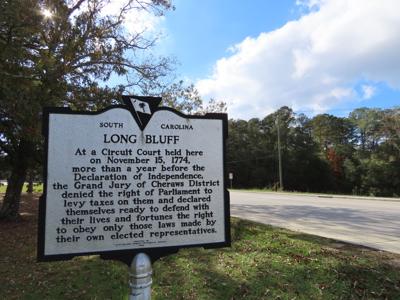
SOCIETY HILL — It was in the backcountry of South Carolina — in wooden courthouses stuffed with traders, planters, timbermen and soldiers — that some of the first seeds of the Revolution were planted. At present-day Camden and Society Hill, South Carolina colonists announced to the world that they could no longer abide British rule. They said they would put their lives on the line to defend their rights.
And they did so nearly two years before Thomas Jefferson wrote the Declaration of Independence. “If we may be taxed, imprisoned, and deprived of life, by force of edicts to which neither we or our Constitutional Representatives have ever assented, no slavery can be more abject than ours,” the men wrote. “This is something that we can be really proud of, as not just South Carolinians but Americans,” John Anderson said, explaining that it sparked a movement in South Carolina that would lead to the founding of the United States.
“This was such a major event, and it took place right in our backyards.” Anderson is president of the 247-year old St. David's Society, which helps preserve the history of the Upper Pee Dee.
On Nov. 16, it will celebrate the 250th anniversary of the declarations at Long Bluff, near what is today Society Hill. Historic reenactments, tours and presentations will help mark a moment in history many have forgotten.
Long Bluff was at the center of the Pee Dee before fading away in the early 1800s. Members of the St. David's Society hope ongoing archaeological work can bring it back to life.
It's worth it, Anderson said. While South Carolina’s declarations — known as the Camden Resolves and the Long Bluff Presentment — don’t have the reputation of the Declaration of Independence, they nonetheless shifted the course of the war by shaping popular sentiment, Anderson said. The movement helped keep the British on the backfoot, leading to their defeat.
“It was a spark to rejuvenate the Revolutionary culture of the area,” Anderson said. In 1774, the colonies were on edge. At the end of 1773, Boston patriots tossed tea into the harbor.
The British Parliament responded by closing the port of Boston and requiring British troops to be housed in taverns and vacant buildings. In September 1774, the first Continental Congress formed to chart a path forward. Snow’s Island was pivotal in the Revolutionary War.
The site will soon be open to the public. But in South Carolina's backcountry, the settlers had little stake in the ideological debates raging up and down the American coast, said Ben Zeigler, secretary of the St. David’s Society and chair of the Archaeological Institute of the Pee Dee.
That changed when a Charleston judge, educated in England and full of Revolutionary ideas, traveled to the backcountry with a mission of his own. Judge William Henry Drayton , one of America’s founding fathers, was born in Charleston. At first, he was a loyal subject of the crown, serving in the South Carolina Royal Assembly.
But after being rebuffed in his attempts to rise the ranks, he switched sides. He became a vocal advocate for the rights of the colonists, Zeigler said. William Henry Drayton traveled South Carolina's backcountry, spreading the ideology that would lead to the Revolutionary War.
“He's the typical overzealous convert. He wants to go into the backcountry and whip all these people into an anti-British fury,” Zeigler said. Drayton stopped at courthouses at Camden and Long Bluff to plant the seeds of revolution.
The two towns served as the center of pioneering settlements in the backcountry. At both courthouses, Drayton brought together notable figures in the community to serve on a grand jury, according to material from the St. David’s Society.
In his charge to the jury, Drayton argued that the citizens of the colonies were citizens of England. Therefore, they couldn't be bound by any law unless they consent to it — or elect representatives who consent to it. As Englishmen, they had “invaluable rights” that could not be infringed upon.
“I charge you to do your duty, to maintain the laws, the rights, the constitution of your country, even at the hazard of your lives and fortunes,” Drayton told the jury. In response, the juries prepared statements that read almost as rough drafts of the Declaration of Independence. They wrote that the colonists could not be ruled without representation, that taxation without representation was invalid and that people have certain inherent rights.
US Navy retires 2nd warship named after pivotal Revolutionary War battle fought in Upstate British officials took notice, at least of the Camden Resolves, said Stacey Ferguson, operations manager at the Historic Camden Foundation. In a 1775 book used by British Parliament to learn what’s happening in the colonies, North Carolina’s governor reported the jury in Camden had asserted “most dangerous and alarming” grievances. “It did make some waves,” Ferguson said.
Community members also took notice, according to Zeigler. While the documents had no legal effect, they were widely distributed, spurring revolutionary sentiment in the backcountry. “I think it was an important example of how the ideology of American independence was brought to the backcountry right at the outset of the war,” Zeigler said.
Years later, anti-British sentiment helped fill Francis Marion’s ranks and prevented the British from gaining a foothold in South Carolina, Zeigler said. With their backs against the wall, troops retreated to Yorktown. There, they eventually surrendered to patriot forces, functionally ending the war.
“What changed the course of the war was not some great battle that took place between two formal European armies. What changed the course of the war in the backcountry of South Carolina was the people,” Zeigler said. Long Bluff takes on special significance for members of the St.
David’s Society who hope the site could provide a small window into what everyday life was like for the people of the Pee Dee who resisted British control. It was one of the Pee Dee's first European settlements, a bustling community for a few dozen years before and after the Revolutionary War before eventually being replaced by Society Hill. By the early 1800s, the settlement had all but disappeared, Zeigler said.
“The world sort of passed Long Bluff by,” Zeigler said. Hidden settlement: Revolutionary-era site in Pee Dee could shed light on SC frontier life Archeological work in the area — which is ongoing — has the potential to uncover the building blocks of these peoples’ lives, Zeigler said: What their homes, churches and courthouses were made of. What they wore.
What they ate. “The material culture is a reflection of the overall culture, which can tell us a lot about how people lived and possibly why they made the decisions they made and why they took the positions they took,” he said. The public is invited to get a taste of Long Bluff and the furor ahead of the Revolutionary War at the Nov.
16 event, which will include professional reenactors, archaeological presentations, a historic home tour and a cemetery tour. Lunch is also included. "It was very impactful," Anderson said of the Long Bluff Presentment.
"And it took place in a part of the state that does not get a whole lot of attention." The event is free and open to the public. To RSVP, click here .
.














